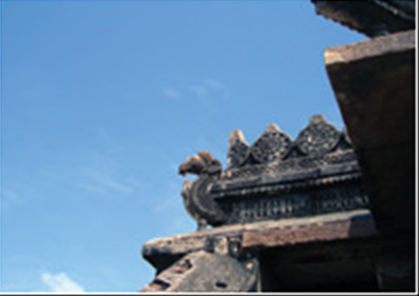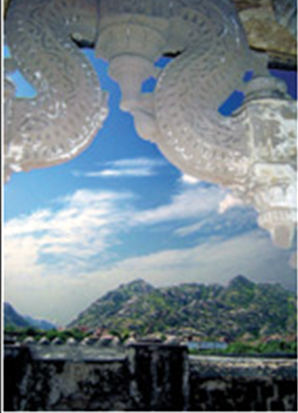Karoonjhar Hills of Tharparkar
This is a collection of articles archived for the excellence of their content. Readers will be able to edit existing articles and post new articles directly |
Contents |
Karoonjhar Hills of Tharparkar, in brief
June 24, 2007
EXCERPTS: Mythology of Karoonjhar
A collection of essays about the ‘mountains’ of Sindh
Dr Allah Nawaz Samo writes about the Karoonjhar Hills of Tharparkar and the emotions, inspirations and myths attached to them
AN ancient Jain temple of the 14th century, built on the slopes of the Karoonjhar Hills in Tharparkar engraves a painting; a vulture swirling over the dancing peacock. The local people believe that the vulture symbolises drought and the peacock portrays the beauty and richness of Thar, where Karoonjhar exists for the last 4.7 billion years.
Perhaps, this beauty is the sole inspiration for people who live in the lap of Karoonjhar, and are emotionally attached to it; they tend to come back after long spells of migration; and prefer dying in hunger than leaving the land of their ancestors.
The Karoonjhar Hills are spread over about 16 miles in the south west of Nagar Parkar. The altitude of Karoonjhar is around one thousand feet above sea level.
Within the periphery of these mountains are many ancient places of interest. There are many signs of the Pan Davas. It is said “when their cousins cast the five brothers out of their kingdom for 13 years, the Pan Davas came to Karoonjhar and spent a short time there.” Till today, signs of their presence are visible in the Karoonjhar Mountain. These places are called by names such as Bhimgodo, Bhim Gaddo (Bhim’s carriage), Bhim Tala (Bhim’s tank) and Arjan Bban (Arjan’s Arrow).
There are many kinds of shrubs to be found here which are used for medical purposes, such as Ghokhro, Gun Wei, Satawri, Jungli Basar, Sev Jati, Uthkunthi, Uthngun and Lajwati (native cotton). In some places, sulphur can be seen in the rocks.
Sometimes during the hot season a very loud rumbling sound echoes from the mountain. It is possible that there are deposits of sulphur, which form gaseous contents that cause such thundering sounds.
In the rainy season, many streams (eight large and four small) flow down the slopes of the mountain with great force towards the marshes of the Ran of Kutch.
Karoonjhar and Parkar remained the centre of civilisation for more than a century. This was the period when beauty, prosperity and rich traditions gave birth to many folk stories. These folk stories mostly of love affairs were indispensably related to the lively sites of Karoonjhar, and as these places turned into archaeological sites with the irony of time/nature, all the folk stories also withered into oblivion.
The foundations of this ancient Sindhi port are reckoned to go back to the first century AD. It is situated 14 miles from Nagar Parkar. Nowadays the neighbourhood of Virawah resembles nothing more than a wilderness of fallen rock, but in its heyday, it is estimated to have been an urban centre inhabited by some forty thousand people.
The communities living in the port city of Parinagar comprised 5,200 Jain dwellings, 900 Luhar, 700 Rajput, 1,300 Lohana, 1,200 dwellings belonging to other castes. Besides, some minority communities included Dhatti, Wora and Gandhi, Garddera, Lalan, Tina, Madar, Kul, Kubbria, Waddera, Mahta, Wegar, Kantia, etc.
The present Ran of Kutch was once a sea and its most ancient and important port was Parinagar. It was always busy with shipping and there was anchorage at Doo-ptar. The word means two landing places and lies two miles to the West of Virawah, where traces of port facilities are still visible. Parinagar, the mosque of Bhoddisar and the temple of Gori are the products of the fishing industry, and when looked at closely appear to have been constructed in very similar style and during the same period. Their dimensions and construction are of extremely fine quality, indicating that the Parkar terrain was once a centre of artists and artisans.
It is said that in bygone days the temples of Parinagar were filled with countless statues. Now all have been destroyed. Those which have survived are all disfigured. The signs of five temples can still be seen. In one of these there is a statue with glass in its eye sockets, shining in the dark. The pieces of iron which formed the supports of the statues can still be seen scattered about.
Kajlasar of Parinagar
The merchant community of Parinagar gathered a substantial amount of money and built water reservoir the Kajlasar. The girls of Parinagar used to come early in the morning to wash their faces. They wore such heavy eye make up kajal that the whole reservoir was covered with lines of black Kohl floating on the surface of the water.
The habit of applying Kohl was particularly prevalent among the Jain women. Their large eyes lined with Kajal suited their pale complexions beautifully. It is said that once an important Rajput prince came early one morning to the reservoir to water his horse. There were many girls at the spot washing their blackened eyes, and of course, the water was streaked with the antimony. The prince was annoyed and remonstrated with the girls for spoiling the water. The story spread and reached the ears of the Oswars who threatened to leave Parinagar.
Excerpted with permission from
Mountains of Sindh
Compiled by Dr Karim Khuwaja
People’s Doctor’s Forum
B-10 Noorani View Appts, Garden Ext, Karachi-3
Tel: 021-2231122,
Cell: 0301-2265637
171pp. Rs300
Dr Allah Nawaz Samo is a social worker
Dr Karim Khuwaja is a psychiatrist by profession. His other compilations include Indus Valley Environmental and Deltaic Crisis
Ambaji temple
Used as a outpost for the Pakistan Rangers
Bharat Yagnik, Ashish Chauhan, March 4, 2019: The Times of India

From: Bharat Yagnik, Ashish Chauhan, March 4, 2019: The Times of India
Near Border Pillar Number 960, on the Pakistani side, one is amazed at a little white temple on a rocky mound which also doubles up as a outpost for the Pakistan Rangers.
BSF personnel deployed at the International Border said that the temple is on a hilltop on Karoonjhar Pahadi — ranges of the Karoonjhar hill — in Bodesar village on the Pakistani side. However, the Indian side also has an advantage to see activities in Pakistan from Nadabet in Banaskantha.
Villagers of Jaloya on the Indian side claim that they sometimes see people visiting the temple to offer prayers.
“We know that it is a temple of Goddess Ambaji. We have seen villagers of Bodesar and Badtalav —another village on Pakistan side — visiting the temple. The other side of the fence also has a large Hindu population who might be visiting the temple,” said Thanaji Dodiya, sarpanch of Jaloya village near Nadabet in Suigam taluka of Banaskantha.
A resident near Nadabet, Bhalji Pandya, said that the hilltop had an ancient temple of Goddess where people from Bodesar and Badtalav in Nagarparkar district in Sindh province of Pakistan used to visit.
“In the past few days, we have been witnessing hectic movement by Pakistan Rangers at this outpost. I have also seen a helicopter of Pakistan hovering around Kalo Dungar (black mountain) of Karoonjhar Pahadi recently,” said Pandya, a retired schoolteacher.
“Nagarparkar, due to a large Hindu population, had many ancient religious places, including Mata Rani Bhatiyani temple, Sachya Mataji temple, an old Jain temple and Lakhan Bharti Ashram. This white temple of Goddess was one of them and now it has been mostly used and occupied by Pakistan Rangers,” said a resident of Jaloya, who used to live in Nagarparkar before 1971 Indo-Pak war.


